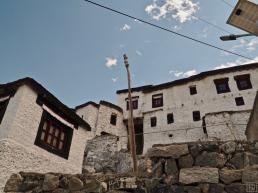I leave Leh & civilisation behind & dig a little bit deeper into the vastness & beauty of Ladakh. I knew this would be a trip of a lifetime. Still, I come back surprised.
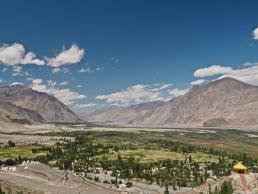
It had now been 7 days since we’d left Delhi behind. We’d been in Leh for the last 3 days. The fact that we were in Ladakh had finally sunk in. Best of all, we were just getting started.
The Lodgy Stepway MPV had faired brilliantly so far. It had taken everything that the Himalayas had thrown at it, in its stride. Remember that the Lodgy is essentially a 7 seat family MPV designed to do school runs, designed to ferry people and luggage on tarmac, not on some of the most challenging roads in the world.
Day 8 of our drive would actually be one of its biggest tests. We’d departed from Leh at 7am and were making our way to Nubra. This meant we’d be crossing Khardung La, once the highest motorable road in the world. At 17500 odd feet, it is pretty high. The approach road to the pass was pretty decent till about 20km before the Khardung La Top. From there on, the tarmac disappeared. In its place was loose gravel, sharp edged rocks and trenches created by the small streams carrying the melting snow.

We could feel the oxygen thinning out. I could feel the car’s power being throttled by the lack of the same too. But with some careful manoeuvring, we reached Khardung La in good time. Got down and soaked in the place for about 5 minutes.
Khardung La has 3-4 settlements serving chai, snacks and Maggi. It’s a welcome stop after the tough drive up to the place. But beware of the oxygen levels at this altitude. It’s advised that one spend not more than 20-30 minutes at Khardung La top. If you feel breathless, please proceed to making your way down from the pass as soon as you can. We stopped at Khardung La for about 5 minutes. By that time, we were gasping for breath, and decided to make our way down the other side of the pass.

If the road up to Khardung La was bad, the road going down was even worse. Another 30km of gravel and loose stone.
Just as we hit the base of the valley, we were greeted by this view. We parked the car to the side, filled up our water bottles from the river and basked in the soft sunshine for the next hour or so. I managed to grab a quick nap on the grass, before we set out towards Nubra again.
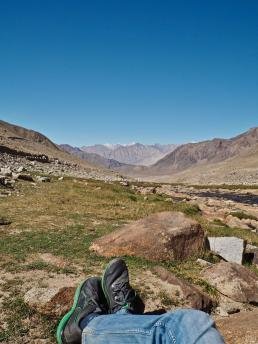
“
We parked the car to the side, filled up our water bottles from the river and basked in the soft sunshine for the next hour or so. I managed to grab a quick nap on the grass, before we set out towards Nubra again.
“
From there on the road to Nubra was pretty good. All in all, the drive from Leh to Nubra took us about 6 hours.
At Nubra, we were staying at Camp Silver Sands. A unit owned by Ladakh Camps & Retreats, Camp Silver Sands is located in Hunder, a stone’s throw away from Nubra’s famous sand dunes. The camp comprises of 20 tents that offer everything that one could need and nothing that one doesn’t. Comfortable beds, electrical charging points (a few hours each day), attached toilets and a patio up front. There’s a common dining area, and an organic garden on the property too.
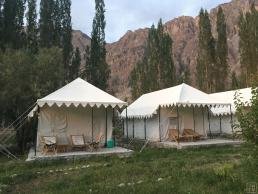
After a quick round of tea and snacks, we headed out to the sand dunes. It’s a weird sight frankly. You have snow covered mountains in the distance, a river cutting through the landscape, lush green fields that have been cultivated over time using the river’s water and sand dunes in the middle of it all. Quite a paradox, isn’t it.

Ladakh is a high altitude desert. That doesn’t mean there’s a shortage of water in the area. The melting snow provides water all year round. It’s classified as a desert because of the meagre rainfall it receives throughout the year.
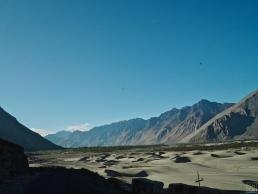
The sand dunes look stunning against the back drop of the snow clad mountains. But the real show unfolds once the sun goes down. The milky way comes out in full force and is visible with your naked eyes. This place is a haven astro-photographers. Nothing makes you feel so small as looking up into the vast expanse of the universe. For once, the mighty Himalayas looked like they’d been dwarfed.

“
For once, the mighty Himalayas looked like they’d been dwarfed.
“
On our 2nd day in Nubra, we headed out to Diskit, the head quarters of Nubra. Diskit is the biggest village in the area, and is home to the Diskit Gompa. The monastery has a Buddha statue on its premises, a pretty large one at that. On the day we visited the monastery, there was a graduation ceremony in progress. One of the monks was graduating to a Lama – a teacher of dharma in Buddhism. It was a jovial atmosphere – with young monks serving snacks, juice and chai. Some prayers were in progress too.
The monastery, like all others, is perched on a hill, and provides fantastic, panoramic views of the Nubra valley. It’s the perfect location to soak in the place. We spent a good 2 hours at the top of the monastery, just gorging at the views in front of us.

In the evening, we descended from the monastery and decided to drive towards Turtuk, an Indian village close to the border with POK (Pakistan Occupied Kashmir). Our aim wasn’t to go all the way to Turtuk, but to just drive around and find a spot where we could get close to the Shyok river.
We stopped about 15km before Changmar. The sun was going down, it was about 6pm, and we decided not to go any further. Instead, we walked down to the river and perched ourselves at the edge.

After about half an hour, we made our way back to Hunder. On the way, we came across a bridge constructed over a stream that was carrying water from the melting snow to the Shyok river. The water was cold, clean and had a greenish tint to it. It made for an extremely photogenic sunset, as can be seen in the photo below.
The light faded by about 7:30pm, and we returned to Camp Silver Sands to enjoy a sumptuous meal and a much needed night’s sleep.
On the following morning, we started early from Nubra. We were to make our way back to Leh, and then drive onwards to Pangong Tso. More on that in the article here.

